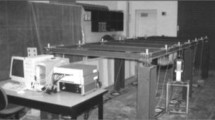Abstract
With increasing number of aging civil structures including bridges, the finite element (FE) analysis assumes key roles in the use of the maintenance and repair design, and structural health monitoring. Despite the changes in dynamic characteristics of the aging structures from the nominal condition due to deteriorations or possible damages, limited attention has generally been paid to the verification and validation (V&V) of the numerical models used in the dynamic analysis. In this paper, we describe some practical considerations on the systematic V&V especially for the modeling of existing and aging bridges by applying a series of V&V procedure to the bridge FE model. The applied V&V procedure includes: (1) experimental data acquisition by impact tests, (2) model verification using grid convergence index, (3) sensitivity analysis to extract influential parameters to the comparative feature, namely the modal parameters, and (4) uncertainty quantification based on Bayesian inference. Posterior probability distributions of uncertain parameters in the FE model, especially material properties of the girders and slab, were then successfully derived in the uncertainty quantification procedure. The study also discusses some important considerations to improve implementation of V&V for the modeling of existing structures in terms of the verification procedure for complex FE models, the choice of comparative features, and the appropriate experimental data acquisition.





Similar content being viewed by others
References
Oberkampf WL, Truncano T (2002) Verification and validation in computational fluid dynamics. Prog Aerosp Sci 38:209–272
Alvin K, Oberkampf WL, Dieger K, Rutherford B (1998) Uncertainty quantification in computational structural dynamics: a new paradigm for model validation. In: Proceedings of the 16th international modal analysis conference
Atamturktur S, Hemez F, Unal C (2010) Calibration under uncertainty for finite element models of masonry monuments. Los Alamos National Laboratory, Los Alamos
Mollineaux M, Van Buren K, Hemez, F (2011) Simulating the dynamics of wind turbine blades: part I, model development and verification. In: 13th AIAA nondeterministic approaches conference
Van Buren K, Mollineaux M, Hemez F (2011) Simulating the dynamics of wind turbine blades: part II, model validation and uncertainty quantification. In: 13th AIAA non-deterministic approaches conference
Jalayer F, Iervolino I, Manfredi G (2010) Structural modeling uncertainties and their influence on seismic assessment of existing RC structures. Struct Saf 32:220–228
Higdon D, Gattiker J, Williams B, Rightley M (2008) Computer model calibration using high-dimensional output. J Am Stat Assoc 103:570–583
Dinh H, Nagayama T, Fujino Y (2011) Structural parameter identification by use of additional known mass and its experimental application. Struct Control Health Monit 19:436–450
Juang JN, Pappa RS (1984) An eigensystem realization algorithm for modal parameter identification and model reduction. NASA/JPL workshop on identification and control of flexible structures
ABAQUS/CAE user’s manual (2008) Dassault systemes
ABAQUS verification manual (2008) Dassault systemes
Roache PJ (1998) Verification and validation in computational science and engineering. Hermosa publishers, Albuquerque
Saltelli A et al (2008) Global sensitivity analysis, the primer. Wiley, London
Guideline of stability design of steel structures (1990) Japanese Society of Civil Engineers (in Japanese)
Kennedy M, O’Hagan A (2000) Predicting the output from a complex computer code when fast approximations are available. Biometrika 87:1–13
Nishio M, Hemez F, Worden K, Park G, Takeda N, Farrar C (2011) Feature extraction for structural dynamics model validation. In: Proceedings of the 29th international modal analysis conference
Acknowledgments
The authors are grateful to the research group in Los Alamos National Laboratory (LANL) for the use of GPM/SA software in the uncertainty quantification procedure, and especially grateful to Dr. Francois Hemez and Dr. Charles Farrar from LANL for meaningful discussions and many advices. The authors also appreciate the kind support by Dr. Dionysius Siringoringo from University of Tokyo in preparing the manuscript.
Author information
Authors and Affiliations
Corresponding author
Rights and permissions
About this article
Cite this article
Nishio, M., Marin, J. & Fujino, Y. Uncertainty quantification of the finite element model of existing bridges for dynamic analysis. J Civil Struct Health Monit 2, 163–173 (2012). https://doi.org/10.1007/s13349-012-0026-z
Received:
Accepted:
Published:
Issue Date:
DOI: https://doi.org/10.1007/s13349-012-0026-z




